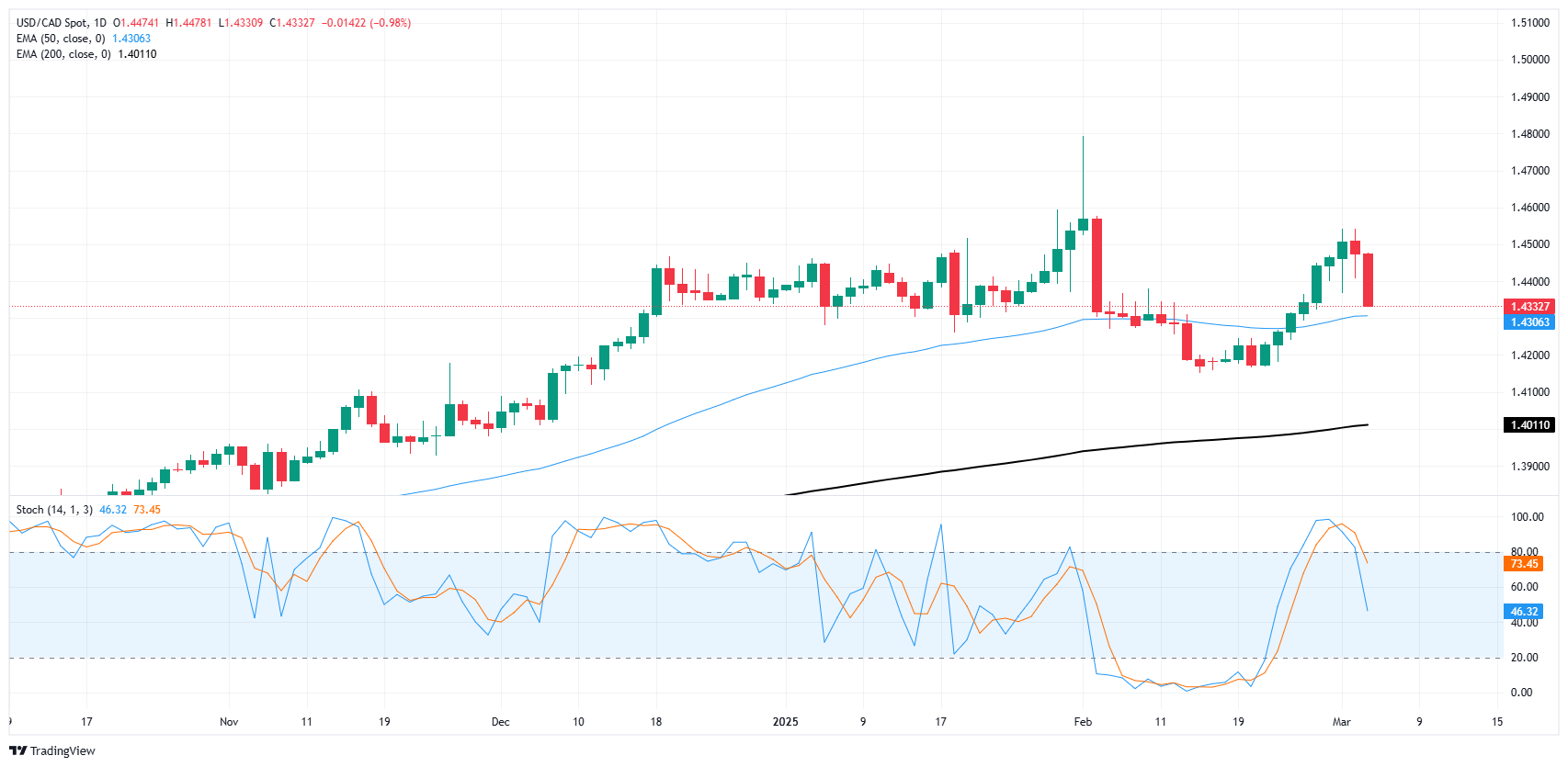- The Canadian Dollar rebounded nearly 1% on Wednesday.
- Loonie markets are recovering as Trump administration pivots on tariffs.
- Key labor figures are due at the end of the week, and NFP looms large.
The Canadian Dollar rallied hard on Wednesday, recovering almost full percent against the US Dollar. The day’s Loonie recovery has pushed USD/CAD lower, forcing bids back into the 50-day Exponential Moving Average (EMA) near the 1.4300 handle.
It took less than 48 hours, but US President Donald Trump is already exploring avenues to provide concessions or extensions for key industries that face ruin at the hands of President Trump’s sweeping tariff agenda. The White House has issued a 30-day exemption for the US automotive industry following the implementation of Donald Trump’s bespoke tariff strategy that imposed a 25% tariff on all goods imported from Canada and Mexico.
Daily digest market movers: Tariffs bode poorly for US industries as policy pivot continues
- The Canadian Dollar pared recent losses, gaining nine-tenths of one percent on Wednesday.
- Loonie markets are recovering ground as the Trump administration begins to pivot away from its own tariff policies.
- Markets are betting on further tariff exemptions and extension in the weeks to come as the Trump administration delays tariffs on US auto makers, which are heavily reliant on foreign trade.
- The Trump team is discovering just how much the US economy relies on efficient trade.
- Key labor data still looms large at the end of the week with Canadian employment figures and another round of US Nonfarm Payrolls net jobs additions.
- Canadian job gains are expected to slow in February, while US net job gains are expected to rebound slightly.
Canadian Dollar price forecast
The Canadian Dollar’s Wednesday rebound has dragged the USD/CAD chart back down into familiar territory, for better or for worse. The prevailing trend is a slow-motion sideways grind, with the Loonie continuously testing multi-year lows against the Greenback.
USD/CAD is inching back into the 50-day EMA at the 1.4300 handle on daily candlesticks, implying the pair could once again run out of gas. However, technical oscillators are showing that Loonie bulls still have some room to run and try to drag USD-based pairs even lower.
USD/CAD daily chart
Canadian Dollar FAQs
The key factors driving the Canadian Dollar (CAD) are the level of interest rates set by the Bank of Canada (BoC), the price of Oil, Canada’s largest export, the health of its economy, inflation and the Trade Balance, which is the difference between the value of Canada’s exports versus its imports. Other factors include market sentiment – whether investors are taking on more risky assets (risk-on) or seeking safe-havens (risk-off) – with risk-on being CAD-positive. As its largest trading partner, the health of the US economy is also a key factor influencing the Canadian Dollar.
The Bank of Canada (BoC) has a significant influence on the Canadian Dollar by setting the level of interest rates that banks can lend to one another. This influences the level of interest rates for everyone. The main goal of the BoC is to maintain inflation at 1-3% by adjusting interest rates up or down. Relatively higher interest rates tend to be positive for the CAD. The Bank of Canada can also use quantitative easing and tightening to influence credit conditions, with the former CAD-negative and the latter CAD-positive.
The price of Oil is a key factor impacting the value of the Canadian Dollar. Petroleum is Canada’s biggest export, so Oil price tends to have an immediate impact on the CAD value. Generally, if Oil price rises CAD also goes up, as aggregate demand for the currency increases. The opposite is the case if the price of Oil falls. Higher Oil prices also tend to result in a greater likelihood of a positive Trade Balance, which is also supportive of the CAD.
While inflation had always traditionally been thought of as a negative factor for a currency since it lowers the value of money, the opposite has actually been the case in modern times with the relaxation of cross-border capital controls. Higher inflation tends to lead central banks to put up interest rates which attracts more capital inflows from global investors seeking a lucrative place to keep their money. This increases demand for the local currency, which in Canada’s case is the Canadian Dollar.
Macroeconomic data releases gauge the health of the economy and can have an impact on the Canadian Dollar. Indicators such as GDP, Manufacturing and Services PMIs, employment, and consumer sentiment surveys can all influence the direction of the CAD. A strong economy is good for the Canadian Dollar. Not only does it attract more foreign investment but it may encourage the Bank of Canada to put up interest rates, leading to a stronger currency. If economic data is weak, however, the CAD is likely to fall.
Information on these pages contains forward-looking statements that involve risks and uncertainties. Markets and instruments profiled on this page are for informational purposes only and should not in any way come across as a recommendation to buy or sell in these assets. You should do your own thorough research before making any investment decisions. FXStreet does not in any way guarantee that this information is free from mistakes, errors, or material misstatements. It also does not guarantee that this information is of a timely nature. Investing in Open Markets involves a great deal of risk, including the loss of all or a portion of your investment, as well as emotional distress. All risks, losses and costs associated with investing, including total loss of principal, are your responsibility. The views and opinions expressed in this article are those of the authors and do not necessarily reflect the official policy or position of FXStreet nor its advertisers. The author will not be held responsible for information that is found at the end of links posted on this page.
If not otherwise explicitly mentioned in the body of the article, at the time of writing, the author has no position in any stock mentioned in this article and no business relationship with any company mentioned. The author has not received compensation for writing this article, other than from FXStreet.
FXStreet and the author do not provide personalized recommendations. The author makes no representations as to the accuracy, completeness, or suitability of this information. FXStreet and the author will not be liable for any errors, omissions or any losses, injuries or damages arising from this information and its display or use. Errors and omissions excepted.
The author and FXStreet are not registered investment advisors and nothing in this article is intended to be investment advice.
Recommended content
Editors’ Picks

AUD/USD: Rally continues to target 0.6400
AUD/USD’s upside momentum remained unchallenged on Tuesday, with the pair rising for the fifth consecutive daily advance and coming at shouting distance from the key resistance area in the 0.6400 neighbourhood.

EUR/USD: Correction has further legs to go
EUR/USD remained under pressure, adding to Monday’s retracement and breaking below the key 1.1300 support to reach two-day troughs, leaving the door open to the continuation of this correction in the short-term horizon.

Gold embarks on a consolidative move around $3,200
Gold is holding its own on Tuesday, trading just above $3,200 per troy ounce as it bounces back from earlier losses. While a more upbeat risk sentiment is bolstering the rebound, lingering concerns over a deepening global trade rift have prevented XAU/USD from rallying too aggressively.

Ethereum staking balance declines as whales resume buying
Ethereum is down 2% on Tuesday following a 120K ETH decline in the net balance of staking protocols in the past five days. While the decreasing staking balance could accelerate selling pressure, the resumption of whale buying activity could help the top altcoin defend a key ascending triangle's support.

Is a recession looming?
Wall Street skyrockets after Trump announces tariff delay. But gains remain limited as Trade War with China continues. Recession odds have eased, but investors remain fearful. The worst may not be over, deeper market wounds still possible.

The Best brokers to trade EUR/USD
SPONSORED Discover the top brokers for trading EUR/USD in 2025. Our list features brokers with competitive spreads, fast execution, and powerful platforms. Whether you're a beginner or an expert, find the right partner to navigate the dynamic Forex market.



